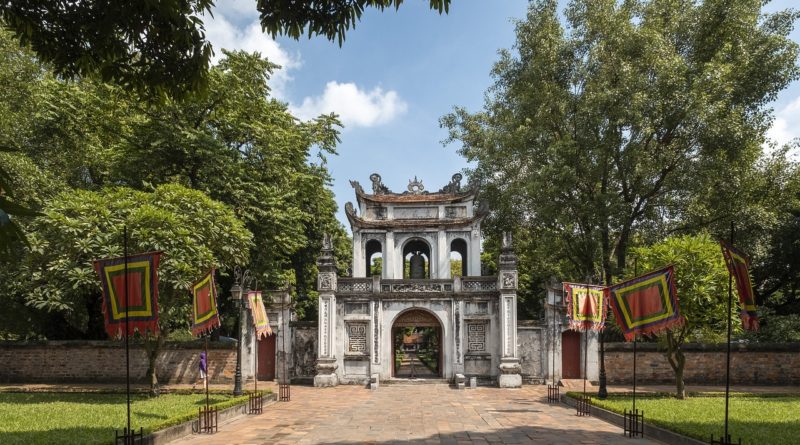Nurturing Wisdom and Heritage: A Journey through Vietnam’s Temple of Literature
Nestled in the heart of Hanoi, the Temple of Literature, or “Văn Miếu” in Vietnamese, stands as a timeless testament to the nation’s rich cultural heritage and commitment to education. With a history spanning over a thousand years, this venerable institution holds the distinction of being Vietnam’s first national university. In this article, we will embark on a journey through the hallowed halls of the Temple of Literature, exploring its historical significance, architectural splendor, and enduring role as a symbol of learning and wisdom.
1. Historical Origins:
The Temple of Literature traces its roots back to 1070 during the reign of Emperor Lý Thánh Tông. Originally established as a Confucian temple dedicated to the worship of Confucius, the revered Chinese philosopher, and his disciples, the site later evolved to become Vietnam’s foremost center of learning. Over the centuries, it underwent expansions and renovations, adapting to the changing socio-political landscape while steadfastly preserving its core values.
2. Architectural Splendor:
The architectural layout of the Temple of Literature reflects a harmonious blend of traditional Vietnamese and Chinese design principles. Surrounded by lush gardens, the complex is divided into five courtyards, each with its own distinctive features. The first courtyard, adorned with a grand entrance gate, welcomes visitors with a sense of reverence. As one progresses through the subsequent courtyards, they encounter beautifully crafted pavilions, ceremonial halls, and stone stelae, contributing to the overall grandeur of the complex.
3. The Stelae of Scholars:
One of the most captivating aspects of the Temple of Literature is the collection of stone stelae, known as the “Stelae of Doctors.” These monuments, erected between the 15th and 18th centuries, commemorate the achievements of scholars who successfully passed the royal examinations. Inscribed on each stela are the names, birthplaces, and accomplishments of the laureates, offering a poignant glimpse into the intellectual prowess of Vietnamese scholars throughout history.
4. The Quoc Tu Giam – Vietnam’s First National University:
At the heart of the Temple of Literature lies the Quoc Tu Giam, Vietnam’s first national university. Established in 1076, this institution played a pivotal role in shaping the country’s intellectual landscape. The university provided education in the Confucian classics, literature, and philosophy, attracting students from across the nation. The Quoc Tu Giam is a testament to Vietnam’s early commitment to education and the cultivation of a learned elite.
5. The Well of Heavenly Clarity:
The Temple of Literature encompasses a serene pond known as the Well of Heavenly Clarity, reflecting the Confucian philosophy of seeking clarity and purity of thought. Surrounded by lush greenery, the well adds a tranquil ambiance to the complex, inviting contemplation and reflection. Its symbolic significance within the temple reinforces the connection between the natural world and the pursuit of knowledge.
6. Cultural and Spiritual Significance:
Beyond its role as an educational institution, the Temple of Literature holds immense cultural and spiritual significance for the Vietnamese people. It serves as a symbol of the nation’s enduring commitment to scholarship, ethics, and the pursuit of wisdom. The temple’s cultural importance is further highlighted during the annual Tet celebrations, where it becomes a focal point for ceremonies and rituals honoring scholars and intellectuals.
7. Preservation and UNESCO Recognition:
In recognition of its historical and cultural importance, the Temple of Literature was designated as a UNESCO World Heritage Site in 2010. This acknowledgment underscores the global significance of the temple as a living testament to Vietnam’s intellectual and educational legacy. Ongoing preservation efforts ensure that future generations can continue to marvel at the architectural brilliance and historical depth of this revered site.
8. Contemporary Relevance:
While the Temple of Literature is a repository of the past, it remains a dynamic and relevant cultural hub in contemporary Vietnam. The site hosts various cultural events, including traditional ceremonies, exhibitions, and academic conferences. It continues to be a place of inspiration for students, scholars, and visitors alike, fostering a deep appreciation for Vietnam’s rich cultural heritage and the enduring importance of education.
Conclusion:
The Temple of Literature stands as a living embodiment of Vietnam’s dedication to wisdom, education, and cultural preservation. From its historical roots as a Confucian temple to its evolution into Vietnam’s first national university, the complex encapsulates the nation’s intellectual journey. As visitors wander through its courtyards, marvel at its architectural splendor, and reflect on the significance of the Stelae of Doctors, they are not merely exploring a physical space but delving into the soul of a nation that reveres knowledge as a cornerstone of its identity. The Temple of Literature remains a timeless beacon, inviting all who enter to partake in the legacy of wisdom that has shaped Vietnam for over a millennium.

